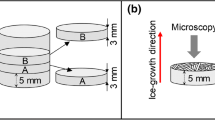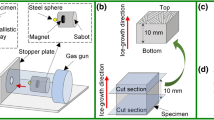Abstract
This study revealed that the mass ratio of large anisometric particles (platelets) to ultrafine, equiaxed particles strongly influences dynamic and quasistatic compressive response and the process of damage evolution in ice-templated alumina materials. The improved sinterability between particles of significantly dissimilar size and morphology enabled the utilization of a high mass ratio of the particles in harnessing a markedly enhanced level of strength in highly porous ice-templated ceramics. The high volume fraction of platelets increased lamellar bridge density and resulted in dendritic morphology as opposed to lamellar morphology without platelets. All the materials showed strain rate-sensitivity, where strength increased with strain rate. Materials with highly dendritic morphology exhibited the best performance in terms of maximum strength and energy absorption capacity, and the performance improved from quasistatic to dynamic regime. Direct observation of the process of damage evolution revealed the effects of both strain rate and ratio of platelets to ultrafine particles.










Similar content being viewed by others
References
K.L. Scotti and D.C. Dunand: Freeze casting–a review of processing, microstructure and properties via the open data repository, FreezeCasting.net. Prog. Mater. Sci. 94, 243 (2018).
G. Shao, D.A.H. Hanaor, X. Shen, and A. Gurlo: Freeze casting: From low-dimensional building blocks to aligned porous structures–a review of novel materials, methods, and applications. Adv. Mater. 32, 1907176 (2020).
M. Naviroj, P.W. Voorhees, and K.T. Faber: Suspension- and solution-based freeze casting for porous ceramics. J. Mater. Res. 32, 3203 (2017).
S. Deville: Ice-templating, freeze casting: Beyond materials processing. J. Mater. Res. 28, 2202 (2013).
F. Bouville, E. Maire, and S. Deville: Lightweight and stiff cellular ceramic structures by ice templating. J. Mater. Res. 29, 175 (2014).
I. Nelson and S.E. Naleway: Intrinsic and extrinsic control of freeze casting. J. Mater. Res. Technol. 8, 2372 (2019).
D. Ghosh, H. Kang, M. Banda, and V. Kamaha: Influence of anisotropic grains (platelets) on the microstructure and uniaxial compressive response of ice-templated sintered alumina scaffolds. Acta Mater. 125, 1 (2017).
D. Ghosh, N. Dhavale, M. Banda, and H. Kang: A comparison of microstructure and uniaxial compressive response of ice-templated alumina scaffolds fabricated from two different particle sizes. Ceram. Int. 42, 16138 (2016).
S. Deville, E. Saiz, R.K. Nalla, and A.P. Tomsia: Freezing as a path to build complex composites. Science 311, 515 (2006).
A. Lichtner, D. Roussel, D. Jauffrès, C.L. Martin, and R.K. Bordia: Effect of macropore anisotropy on the mechanical response of hierarchically porous ceramics. J. Am. Ceram. Soc. 99, 979 (2016).
S. Akurati, D. Ghosh, M. Banda, and D. Terrones: Direct observation of failure in ice-templated ceramics under dynamic and quasistatic compressive loading conditions. J. Dyn. Behav. Mater. 5, 463 (2019).
M. Banda and D. Ghosh: Effects of porosity and strain rate on the uniaxial compressive response of ice-templated sintered macroporous alumina. Acta Mater. 149, 179 (2018).
R. Parai, T. Walters, J. Marin, S. Pagola, G.M. Koenig Jr., and D. Ghosh: Strength enhancement in ice-templated lithium titanate Li4Ti5O12 materials using sucrose. Materialia 14, 100901 (2020).
S. Akurati, J. Marin, B. Gundrati, and D. Ghosh: Assessing the role of loading direction on the uniaxial compressive response of multilayered ice-templated alumina-epoxy composites. Materialia 14, 100895 (2020).
M.M. Porter, R. Imperio, M. Wen, M.A. Meyers, and J. McKittrick: Bioinspired scaffolds with varying pore architectures and mechanical properties. Adv. Funct. Mater. 24, 1978 (2014).
D. Ghosh, M. Banda, H. Kang, and N. Dhavale: Platelets-induced stiffening and strengthening of ice-templated highly porous alumina scaffolds. Scr. Mater. 125, 29 (2016).
I. Ozer, E. Suvaci, B. Karademir, J. Missiaen, C. Carry, and D. Bouvard: Anisotropic sintering shrinkage in alumina ceramics containing oriented platelets. J. Am. Ceram. Soc. 89, 1972 (2006).
R.C. Bradt, D. Hasselman, D. Munz, M. Sakai, and V.Y. Shevchenko: Fracture Mechanics of Ceramics (Springer Science & Business Media, Inc., New York, NY, 2005).
J. Lankford: Mechanisms responsible for strain-rate-dependent compressive strength in ceramic materials. J. Am. Ceram. Soc. 64, C–33 (1981).
J. Lankford, W. Predebon, J. Staehler, G. Subhash, B. Pletka, and C. Anderson: The role of plasticity as a limiting factor in the compressive failure of high strength ceramics. Mech. Mater. 29, 205 (1998).
D. Ghosh, M. Banda, J.E. John, and D.A. Terrones: Dynamic strength enhancement and strain rate sensitivity in ice-templated ceramics processed with and without anisometric particles. Scr. Mater. 154, 236 (2018).
R. Asthana and S.N. Tewari: Review–the engulfment of foreign particles by a freezing interface. J. Mater. Sci. 28, 5414 (1993).
C. Körber and G. Rau: Interaction of particles and a moving ice-liquid interface. J. Crys. Growth 72, 649 (1985).
V. Naglieri, H.A. Bale, B. Gludovatz, A.P. Tomsia, and R.O. Ritchie: On the development of ice-templated silicon carbide scaffolds for nature-inspired structural materials. Acta Mater. 61, 6948 (2013).
M. Banda and D. Ghosh: Effects of temperature and platelets on lamella wall microstructure, structural stability, and compressive strength in ice-templated ceramics. Materialia 9, 100537 (2020).
G. Ravichandran and G. Subhash: Critical appraisal of limiting strain rates for compression testing of ceramics in a split Hopkinson pressure bar. J. Am. Ceram. Soc 77, 263 (1994).
G. Subhash and G. Ravichandran: Split-Hopkinson pressure bar testing of ceramics. In ASM Handbook Volume 8–Mechanical Testing and Evaluation (ASM International, Materials Park, OH, 2000); pp. 497.
L. Li, Z. Li, X. Li, X. Xu, A. Guo, J. Liu, and H. Du: Influence of fibers on the microstructure and compressive response of directional ice-templated alumina ceramics. J. Eur. Ceram 38, 3595 (2018).
M.D. Goel, M. Peroni, G. Solomos, D.P. Mondal, V.A. Matsagar, A.K. Gupta, M. Larcher, and S. Marburg: Dynamic compression behavior of cenosphere aluminum alloy syntactic foam. Mater. Des 42, 418 (2012).
Z.Y. Dou, L.T. Jiang, G.H. Wu, Q. Zhang, Z.Y. Xiu, and G.Q. Chen: High strain rate compression of cenosphere-pure aluminum syntactic foams. Scr. Mater 57, 945 (2007).
D. Ghosh, A. Wiest, and R.D. Conner: Uniaxial quasistatic and dynamic compressive response of foams made from hollow glass microspheres. J. Eur. Ceram 36, 781 (2016).
A. Paul and U. Ramamurty: Strain rate sensitivity of a closed-cell aluminum foam. Mater. Sci. Eng. A 281, 1 (2000).
D.K. Balch, J.G. O'Dwyer, G.R. Davis, C.M. Cady, G.T. Gray, and D.C. Dunand: Plasticity and damage in aluminum syntactic foams deformed under dynamic and quasi-static conditions. Mater. Sci. Eng. A 391, 408 (2005).
J.A. Santa Maria, B.F. Schultz, J. Ferguson, N. Gupta, and P.K. Rohatgi: Effect of hollow sphere size and size distribution on the quasi-static and high strain rate compressive properties of Al-A380–Al2O3 syntactic foams. J. Mater. Sci 49, 1267 (2014).
Q. Li, I. Magkiriadis, and J.J. Harrigan: Compressive strain at the onset of densification of cellular solids. J. Cell. Plast 42, 371 (2006).
X.-q. Cao, Z.-h. Wang, L.-m. Zhao, and G.-t. Yang: Effects of cell size on compressive properties of aluminum foam. Trans. Nonferrous Met. Soc 16, 351 (2006).
C. Park and S. Nutt: Strain rate sensitivity and defects in steel foam. Mater. Sci. Eng. A 323, 358 (2002).
A. Rabiei, and M. Garcia-Avila: Effect of various parameters on properties of composite steel foams under variety of loading rates. Mater. Sci. Eng. A 564, 539 (2013).
Y. Alvandi-Tabrizi, D.A. Whisler, H. Kim, and A. Rabiei: High strain rate behavior of composite metal foams. Mater. Sci. Eng. A 631, 248 (2015).
B. Zhang, Y. Lin, S. Li, D. Zhai, and G. Wu: Quasi-static and high strain rates compressive behavior of aluminum matrix syntactic foams. Compos. B. Eng 98, 288 (2016).
P. Li, N. Petrinic, C. Siviour, R. Froud, and J. Reed: Strain rate dependent compressive properties of glass microballoon epoxy syntactic foams. Mater. Sci. Eng. A 515, 19 (2009).
M. Vural and G. Ravichandran: Dynamic response and energy dissipation characteristics of balsa wood: experiment and analysis. Int. J. Solids. Struct 40, 2147 (2003).
W.D. Callister and D.G. Rethwisch: Materials Science and Engineering, 7th ed. (John Wiley & Sons Inc, New York, 2011), pp. 344.
J. Lankford: Compressive strength and microplasticity in polycrystalline alumina. Mater. Sci 12, 791 (1977).
Z. Wang and P. Li: Dynamic failure and fracture mechanism in alumina ceramics: Experimental observations and finite element modelling. Ceram. Int. 41, 12763 (2015).
P.J. Tan, J.J. Harrigan, and S.R. Reid: Inertia effects in uniaxial dynamic compression of a closed cell aluminium alloy foam. Mater. Sci 18, 480 (2002).
G. Subhash, Q. Liu, and X.-L. Gao: Quasistatic and high strain rate uniaxial compressive response of polymeric structural foams. Int. J. Impact Eng 32, 1113 (2006).
V.S. Deshpande and N.A. Fleck: High strain rate compressive behaviour of aluminium alloy foams. Int. J. Impact Eng 24, 277 (2000).
J.J. Harrigan, S.R. Reid, and C. Peng: Inertia effects in impact energy absorbing materials and structures. Int. J. Impact Eng 22, 955 (1999).
S.R. Reid and C. Peng: Dynamic uniaxial crushing of wood. Int. J. Impact Eng 19, 531 (1997).
C.R. Calladine and R.W. English: Strain-rate and inertia effects in the collapse of two types of energy-absorbing structure. Int. J. Impact Eng 26, 689 (1984).
T.G. Zhang and T.X. Yu: A note on a ‘velocity sensitive’ energy-absorbing structure. Int. J. Impact Eng 8, 45 (1989).
Acknowledgment
This work was partially supported by the Thomas F. and Kate Miller Jeffress Memorial Trust, Bank of America, Trustee.
Author information
Authors and Affiliations
Corresponding author
Supplementary material
Supplementary material
To view supplementary material for this article, please visit https://doi.org/10.1557/jmr.2020.297.
Rights and permissions
About this article
Cite this article
Banda, M., Akurati, S. & Ghosh, D. Governing role of the ratio of large platelet particles to ultrafine particles on dynamic and quasistatic compressive response and damage evolution in ice-templated alumina ceramics. Journal of Materials Research 35, 2870–2886 (2020). https://doi.org/10.1557/jmr.2020.297
Received:
Accepted:
Published:
Issue Date:
DOI: https://doi.org/10.1557/jmr.2020.297




